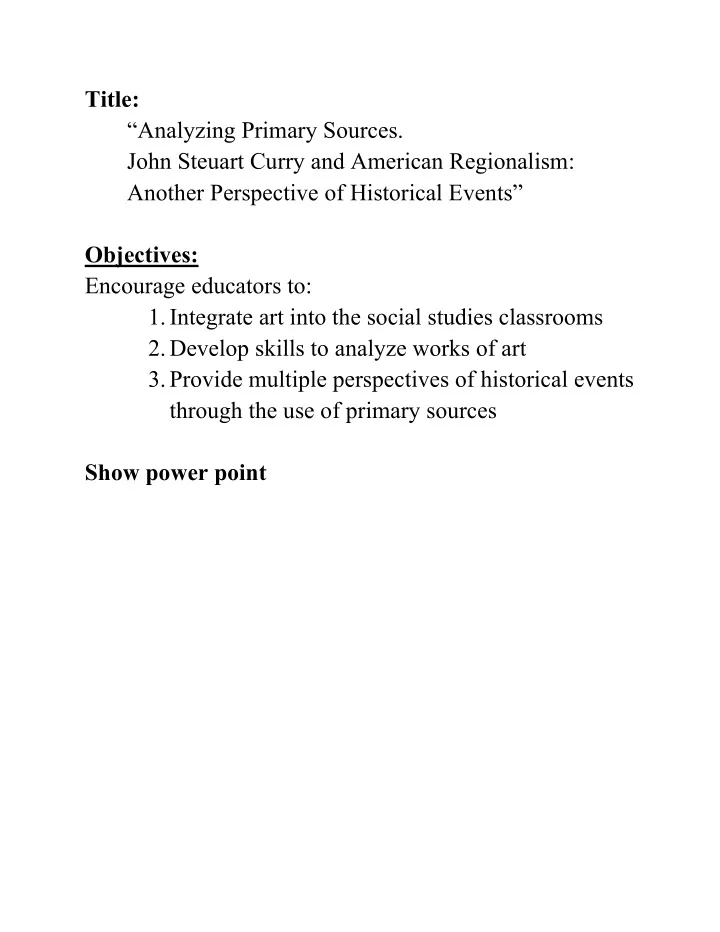

Title: “Analyzing Primary Sources. John Steuart Curry and American Regionalism: Another Perspective of Historical Events” Objectives: Encourage educators to: 1. Integrate art into the social studies classrooms 2. Develop skills to analyze works of art 3. Provide multiple perspectives of historical events through the use of primary sources Show power point
Distribute CD “Beyond the Archives: Art, Music and Literature as Primary Sources” Lists a variety of ways to use art, music and literature Key area: in terms of our discussion Art and History Tutorial Good for listing suggestions for integrating art and history Some sections of music can’t be accessed Show: Home page Beyond the Archive Power Point 2010 Beyond the Archive Power Point 2010 (areas that apply to the presentation) Introduction Ride by Terror by James Turnbull Semiotics 101 Power Point Good for time, validity, intention, etc. -------------------------------------------------------------------------------------------- Beyond the Archive PowerPoint Earlier Versions (not accessible) Activities and Supporting Materials Semiotics 101 Power Point Semiotics (study of signs and symbols) 101: Artworks Addressing Terrorism Artwork Analysis Sheet Denotation and Connotation Artwork Information James Turnbull information Artworks Various paintings Writing Resistance: Slave Culture through Literature Not pertinent Listening to History: Crossover Songs and Musical Genres Not pertinent Anticipatory Set a. Project black/white image of image of Will Brown being burned (power point.) Or give participants a hard copy b. Distribute handout “Using art as a primary source” c. Give teachers a few minutes to review d. Discuss participants’ comments
Procedures: 1. Give teachers copy of “Art Analysis Worksheet” 2. Assign the following questions to groups of teachers Group 1: Questions 1-2 Group 2: Questions 3-4 Group 3: Questions 5-8 3. Visit painting of “Manhunt” 4. Return to class and have teachers share their answers 5. If time, have teachers compare/contrast (Do not tell teachers any details, author, etc.) “The Fugitive” by Curry and “Ride by Terror” by James Turnbull 6. Give teachers copies of “Compare and Contrast Chart Graphic Organizer” 7. Give teachers a few minutes and then discuss images Culminating activity 1. Distribute remaining handouts Reading Like A Historian What Questions Do We Ask of the Past? Thinking Like A Historian History’s Habits of the Mind Primary Sources Help Teach and Reinforce Historical Thinking Skills Nebraskastudies.org main page Race Riot in Omaha 1919 Weblesson @ School. Historical Thinking Skills Teacher’s Guide Analyzing Primary Sources (LOC) Primary Source Analysis Tool (LOC) Photo Analysis Worksheet (Nat. Archives) Guideline for Using Primary Sources Boeing Learning Center. Nat. Archives) Bibliography Compare and Contrast (Graphic Organizer with 3 circles) Compare and Contrast 3 Items (Graphic Organizer with triangle) Ven Diagrma (Graphic Organizer with 2 circles) Distributed during presentation Using the Art as a primary source HistoryWorks: Art Analysis Worksheet Compare and Contrast Chart Graphic Organizer (with columns/boxes) 2. How would/do teachers use art in the social studies classroom?
Images John Brown “Tragic Prelude” 1937 Steuart, John Curry “the Fugitive” 1935 Steuart, John Curry “Manhunt” 1935 Burning of Will Brown. Nebraskastudies.org Racial Tensions in Nebraska after WWI. A Horrible Lynching in Omaha. 1919. James Turnbull “Southern Night” 1941 James Turnbull “Ride by Terror” 1941 Topics Lynching Reconstruction Civil War Art: American Regionalist Movement Rural life in the Midwest Left-leaning politics John Brown Great Depression Communist Organizations Ku Klux Klan Labor unrest. Competition for jobs. Increased immigration Racial Conflict Race and ethnicity Great Depression
Works of art from the past can tell us a. How people live b. What they ate c. What their religious, political, cultural and philosophical ideas were d. What historical events were valued Artworks as Primary Sources Artworks make great primary sources but there are things to keep in mind: a. Are representational and interpretive b. Do not take an artwork at face value c. It is rarely if ever a direct record of a person, place, object or event
Intention Artists work with intention. Determining that intention will aid in understanding the artwork. a. Viewers view with intention. b. Who else has written about this artwork or artist? c. What can their findings reveal? d. How does our own personal experience affect our understanding of the work of art Validity All interpretations are valid—though some are more valid then others. Be patient and persistent in seeking out those interpretations. a. Artworks are emotional and persuasive b. Do not ignore your emotional and personal reactions c. Enjoy them and allow them to help in your interpretation
Time Artworks are temporal. Understand the time in which the work of art was created helps us understand the art and the time period. Art is a conversation. By entering the dialogue we added to the meaning.
Recommend
More recommend